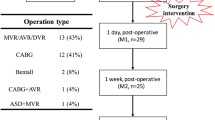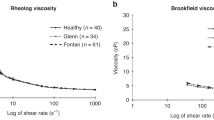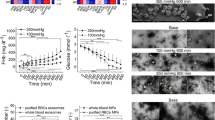Abstract
Evidence is accumulating that blood flow patterns in the cardiovascular system and in cardiovascular devices do, in some instances, depend on blood viscoelasticity. Thus, to better understand the challenges to providing circulatory support and surgical therapies for pediatric and adult patients, viscous and elastic components of complex blood viscoelasticity of 31 pediatric patients were compared to those of 29 adult patients with a Vilastic-3 rheometer. A random effects model with categorical age covariates found statistically significant differences between pediatric and adult patients for log viscosity (p = 0.005). Log strain (p < 0.0001) and hematocrit (p < 0.0001) effects were also significant, as were the hematocrit-by-log-strain (p = 0.0006) and age-by-log strain (p = 0.001) interactions. The hematocrit-by-age interaction was not significant. For log elasticity, age differences were insignificant (p = 0.39). The model for log elasticity had significant log strain (p < 0.0001), log strain squared (p < 0.0001) and hematocrit (p < 0.0001) effects, as well as hematocrit-by-log-strain and hematocrit-by-log-strain-squared interactions (p = 0.014). A model for log viscosity with continuous age was also fit to the data, which can be used to refine cardiovascular device design and operation to the age of the patient. We conclude that there are distinct differences between pediatric and adult blood viscosity, as well as substantial variation within the pediatric population, that may impact the performance of devices and procedures.



Similar content being viewed by others
References
Anadere, I., H. Chmiel, H. Hess and G. B. Thurston. Clinical blood rheology. Biorheology 16:171–178, 1979.
Anwar, M. A., M. W. Rampling, S. Bignall and R. P. Rivers. The variation with gestational age of the rheological properties of the blood of the new-born. Br. J. Haematol. 86(1):163–168, 1994.
Bachmann, C., G. Hugo, G. Rosenburg, et al. Fluid dynamics of pediatric ventricular assist device. Artif. Organs 24: 362–372, 2000.
Baldwin, J. T., H. S. Borovetz, B. W. Duncan, M. J. Gartner, R. K. Jarvik, W. J. Weiss and T. R. Hoke. The National Heart Lung and Blood Institute Pediatric Ciruclatory Support Program. Circulation 113:147–155, 2006.
Baldwin, J. T., H. S. Borovetz, B. W. Duncan, M. J. Gartner, R. K. Jarvik and W. J. Weiss. The National Heart, Lung, and Blood Institute Pediatric Circulatory Support Program: a summary of the 5-year experience. Circulation 123:1233–1240, 2011.
Blume, E. D., D. N. Rosenthal, J. W. Rossano, J. T. Baldwin, P. Eghtesady, D. L. S. Morales, R. S. Cantor, J. Conway, A. Lorts, C. S. Almond, D. C. Naftel, J. K. Kirklin and PediMACS Investigators. Outcomes of children implanted with ventricular assist devices in the United States: first analysis of the Pediatric Interagency Registry for Mechanical Circulatory Support (PediMACS). J. Heart Lung Transplant 35:578–584, 2016.
Burton, A. C. Physiology and Biophysics of the Circulation. Chicago: Year Book Medical Publishers Incorporated, 1972, pp. 39–48.
Cheung A., K. Chorpenning, D. Tamez, C. Shambaugh, Jr, A. E. Dierlam, M. E. Taskin, M. Ashenuga, C. Reyes and J. A. LaRose. Design concepts and preclinical results of a miniaturized HeartWare platform: The MVAD system. Innovations 10:3:151–156, 2015.
Chmiel, H., I. Anadere and E. Walitza. The determination of blood viscoelasticity in clinical hemorheology. Clin. Hemorheol. 10:363–374, 1990.
Eckmann D. M., S. Bowers, M. Stecker and A. Cheung. Hematocrit, volume expander, temperature, and shear rate effects on blood viscosity. Anesth. Analg. 91: 539–545, 2000.
Foley, M. E., D. M. Isherwood and G. P. McNichol. Viscosity, haematocrit, fibrinogen and plasma proteins in maternal and cord blood. Br. J. Obstet. Gynaecol. 85:500–504, 1978.
Giridharan, G. A., S. C. Koenig, K. G. Soucy, Y. Choi, T. Pirbodaghi, C. R. Bartoli, G. Monreal, M. A. Sobieski, E. Schumer, A. Cheng and M. S. Slaughter. Left ventricular volume unloading with axial and centrifugal rotary blood pumps. ASAIO J. 61:292–300, 2015.
Good, B. C., S. Deutsch, and K. B. Manning. Hemodynamics in a pediatric ascending aorta using a viscoelastic pediatric blood model. Ann. Biomed. Eng. 44(4):1019–1035, 2016.
Heatley G., P. Sood, D. Goldstein, N. Uriel, J. Cleveland, D. Middlebrook and M. R. Mehra. Clinical trial design and rationale of the multicenter study of MagLev technology in patients undergoing mechanical circulatory support therapy with HeartMate 3 (MOMENTUM 3) investigational device exemption clinical study protocol. J Heart Lung Transplant 35:528–536, 2016.
Isogai, Y., S. Ikemoto and K. Kuchiba. Abnormal blood viscoelasticity in diabetic microangiopathy. Clin. Hemorheol. 11: 175–182, 1991.
Käber, U., H. Kroemer, G. Altrock and P. Heimburg. Reference ranges of viscoelasticity of human blood. Biorheology, 25: 727–741, 1988.
Kameneva, M. V., J. F. Antaki, H. S. Borovetz, B. P. Griffith, K. C. Butler, K. K. Yelswarapu, M. J. Watach and R. L. Kormos. Mechanisms of red blood cell trauma in assisted circulation: rheologic similarities of red blood cell transformations due to natural aging and mechanical stress. ASAIO J. 41(3):M457–M460, 1995.
Kasser, U., P. Heimburge and E. Walitza. Viscoelasticity of whole blood and its dependence on laboratory parameters. Clin. Hemorheol. 9:307–312, 1989.
Kormos, R. L., H. S. Borovetz, B. P. Griffith and T. C. Hung. Rheologic abnormalities in patients with the Jarvik-7 total artificial heart. ASAIO J. 33:413–417, 1987.
Leverett, L. B., J. D. Hellums, C. P. Alfrey and E. C. Lynch. Red blood cell damage by shear stress. Biophys. J. 12: 257–273, 1972.
Long, J. A., A. Ündar, K. B. Manning and S. Deutsch. Viscoelasticity of pediatric blood and its implications for the testing of a pulsatile pediatric blood pump. ASAIO J. 51:563–566, 2005.
Long, T. C., J. J. Pearson, A. C. Hankinson, S. Deutsch and K. B. Manning. An in vitro fluid dynamic study of pediatric cannulae: the value of animal studies to predict human flow. J. Biomech. Eng. 134:044501-1–044501-16, 2012.
Merchant, R. H., S. D. Phadke, V. S. Sakhalkar, V. S. Agashe and R. R. Puniyani. Hematocrit and whole blood viscosity in newborns: analysis of 100 cases. Indian Pediatr. 29: 555–561, 1992.
Moazami, N., K. I. Fukamachi, M. Kobayashi, N. G. Smedira, K. J. Hoercher, A. Massiello, S. Lee, D. J. Horvath and R. C. Starling. Axial and centrifugal continuous-flow rotary pumps: a translation from pump mechanics to clinical practice. J. Heart Lung Transplant. 32:1–11, 2013.
O’Connor, M. J. and J. W. Rossano. Ventricular assist devices in children. Curr. Opin. Cardiol. 29:113–121, 2014.
Pantalos, G.M., D.E. Abel, A. Ravisankar, T. J. Horrell, C. Lind, A. Funk, E. A. Austin III and C. E. Mascio. In vitro pum** performance evaluation of the Ension pediatric cardiopulmonary assist system for venoarterial and venovenous ECMO. Cardiovasc. Eng. Technol. 3(3):250–262, 2012.
Rampling, M. W., P. Whittingstall, G. Martin, S. Bignall, R. P. Rivers, T. J. Lissauer and P. C. Bailey. A comparison of the rheologic properties of neonatal and adult blood. Pediatr. Res. 25(5):457–460, 1989.
Rossano, J. W., A. Lorts, C. J. VanderPluym, A. Jeewa, K. J. Guleserian, M. S. Bleiweis, O. Reinhartz, E. D. Blume, D. N. Rosenthal, D. C. Naftel, R. S. Cantor and J. K. Kirklin. Outcomes of pediatric patients supported with continuous-flow ventricular assist devices: A report from the pediatric interagency registry for mechanical circulatory support (PediMACS). J. Heart Lung Transplant 35:585–590, 2016.
Sahoo, T. K., S. Chauhan, A. Bisoi and U. Kiran. Effects of hemodilution on outcome after modified Blalock–Taussig shunt operation in children with cyanotic congenital heart disease. J. Cardiothorac. Vasc. Anesth. 21(2):179–183, 2007.
Slaughter M. S., C. R. Bartoli, M. A. Sobieski, G. M. Pantalos, G. A. Giridharan, R. D. Dowling, S. D. Prabhu, D. J. Farrar and S. C. Koenig. Intraoperative evaluation of the HeartMate II flow estimator. J Heart Lung Transplant. 28(1):39–43, 2009.
Stadler, A. and O. Linderkamp. Flow behavior of neonatal and adult erythrocytes in narrow capillaries. Microvasc. Res. 37(3):267–279, 1989.
Stiller, B., C. Benk and C. Schlensak. Mechanical cardiovascular support in infants and children. Heart 97:596–602, 2011.
Thompson, L. O., M. Loebe and G. P. Noon. What price support? Ventricular assist device induced systemic response. ASAIO J. 49:518–526, 2003.
Thoratec Corp. HeartMate III left ventricular assist system instructions for use. Document: 10002832.C, September 2015.
Thurston, G. B. Viscoelasticity of human blood. Biophys. J. 12:1205, 1972.
Thurston, G. B. Erythrocyte rigidity as a factor in blood rheology: viscoelastic dilatancy. J. Rheol. 23:6:703–719, 1979.
VanderPluym, C. J., F. Fynn-Thompson and E. D. Blume. Ventricular assist devices in children: progress with an orphan device application. Circulation 129:1530–1537, 2014.
Walters, H. L., M. Hakimi, M. D. Rice, J. M. Lyons, G. C. Whittlesey and M. D. Klein (1995). Pediatric cardiac surgical ECMO. Ann. Thorac. Surg. 60:329–337, 1995.
Yamarat, P., C. Sanghirun, Y. Chantachum, C. Cheeramakara and W. Thanomsak. Factors influencing blood viscosity: adult and newborn flood analysis. Southeast Asian J. Trop. Med. Public Health 31(Suppl 1):75–78, 2000.
Acknowledgments
We would like to express our appreciation to the patients who were willing to participate in this investigation and to students who provided technical assistance in the evaluation of the blood samples.
Conflict of Interest
Sharp, Gregg, Brock, Nair, Sahetya, Austin, Mascio, Slaughter, and Pantalos declare no conflicts of interest.
Funding
This project was provided by the National Institutes of Health Heart, Lung and Blood Institute (Grant 2 R44 HL059810 and Contract No. HHSN268200449189C), the Jewish Hospital & St. Mary’s Foundation (Louisville, KY), and Kosair Charities, Louisville, KY.
Human and Animal Studies
Human studies were performed in accordance with Institutional Review Board and Helsinki standards. No animals were involved.
Author information
Authors and Affiliations
Corresponding author
Additional information
Associate Editors Keefe B. Manning and Ajit P. Yoganathan oversaw the review of this article.
Electronic supplementary material
Below is the link to the electronic supplementary material.
Rights and permissions
About this article
Cite this article
Sharp, M.K., Gregg, M., Brock, G. et al. Comparison of Blood Viscoelasticity in Pediatric and Adult Cardiac Patients. Cardiovasc Eng Tech 8, 182–192 (2017). https://doi.org/10.1007/s13239-017-0300-7
Received:
Accepted:
Published:
Issue Date:
DOI: https://doi.org/10.1007/s13239-017-0300-7




